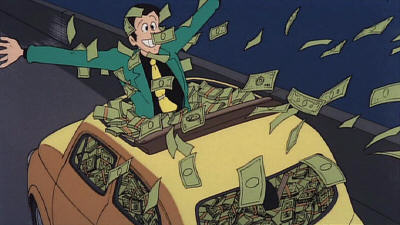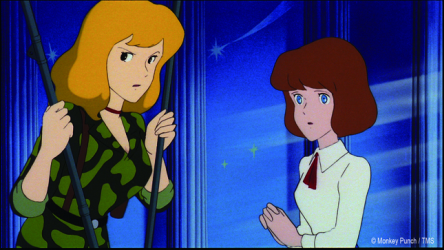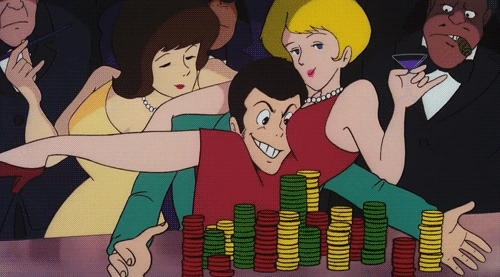We missed the Schwarz-tember (still sounds more Jewish to me than Austrian) showing of The Running Man in order to catch Lupin III: The Castle of Cagliostro which was Hayao Miyazaki’s first film, and the only film he made for someone else, I think. (Next week’s film, Nausicaa of the Valley of the Wind would be his second film, not technically a Ghibli film because the studio hadn’t been formed, but also not “for” anyone else. And there’s your Japanimation lesson right there.)

Our hero after his first heist. (He’s driving, btw.)
I figured it would be pretty good, but my interest was mainly historical. I expected there to be flashes of interest in-and-amongst bits of goofy ’70s-era Japanese TV-level stuff. Before the movie started, there was an interview with John Lasseter and the creepy Fathom Events host, and Lasseter was just hammering how great this movie was. So funny, and great art and…
We all got a little nervous at that point. It was ten minutes of solid hype. And I know Lasseter is a huge Miyazaki fan, but could this (doubtless primitive) 1979-movie-based-on-a-series-based-on-a-Manga hold up under this kinds of expectations? (Apparently, he wooed his wife with this film!) It’s so funny, he said, many times over, often echoed by host-who-needs-haircut-and-better-fitting-clothes. Still…I think if you scaled it for inflation, the film made today would have something like a million dollar budget—and it wasn’t a hit at the time. Retroactively, sure, but people can be generous with their heroes.
And…mirabile dictu!…it actually is great. You do get all the historical aspects of it; The Flower and I were busy nudging each other at parts we would see turn up in later films, like the robots from Castle In The Sky (1986) and the already baked in influences, like the castle tower you can only reach through the retractable bridge (The King and the Mockingbird), and yes, there is a scene which would become basically a hallmark of Ghibli: A moment of near perfect calm, where nothing is happening.

Your moment of zen.
On that last point, it’s kind of a funny thing: The Japanese in general and Miyazaki in particular are not afraid to let a film breathe. They will take a long moment to show something beautiful or wondrous, where nothing is happening. The best ones use it either to contrast something else, or to set up an emotional moment or character shift. Occasionally, you can see it as a climax, where the hero, given a chance to breathe, figures a way out of his problems. American animators used to not be afraid of it so much, but now they all ooh-and-aah at Miyazaki-san’s pauses while treating any moment of calm in their own films like radioactive poison.
This, by the way, seems to include Lasseter. The closest any of us could think of to such a moment in a recent animation was the sloth scene in Zootopia, and that’s a gag with terrific reaction shots. Not the same beast.
And also, one suspects, it wasn’t the mode in the Japanimation of the day, either, since in this case, it’s a guy changing a tire. He’s not the focus of the action and the “camera” drifts to a nearby flowered field while it’s going on. But the spirit is there as the characters take a moment to enjoy life—right before chasing after some gangsters who are pursuing a beautiful fleeing girl into the mysterious country of Cagliostro. (The whole thing takes place in a fictional European country and is a typically delightfully askew view of Europe from the Orient.)

His good nature is infectious.
The story is that the international thief Lupin III, fresh from a casino heist where he steals all the money only to discover that it’s counterfeit—a thing he finds hilarious—decides to see if he can find the counterfeiters and muscle in on their action. While changing a flat tire, he sees the girl fleeing from the gun-toting mafioso and (with his trusty friend Jigen, the best shot in the world!) saves her from their evil clutches…almost. As they abscond with her, he pursues them into Cagliostro and proceeds to figure out how to free her.
He calls for help from Ishikawa, his Samurai pal, and in checking out the place, he discovers Fujiko—his lady love/femme fatale/occasional caper co-conspirator—already performing a heist on the premises. What we learn is that there was a terrible fire about ten years back and the young lord of the castle died. The deceased lord’s sister, Clarisse is to be wed to the Count, thus consolidating Cagliostro under his authority and also…something else more mysterious and Gothic. (That whole marry-your-uncle/cousin thing is very Gothic romance-y. I wasn’t clear on their relationship, but they would actually be pretty distant cousins, he being from a branch that separated 500 years earlier.)

Fujiko and the Princess Clarisse.
It is, as Mr. Lasseter says, very funny. It’s also very quick without feeling frantic, as Japanimation from that era can. It’s romantic, in that Clarisse finds herself falling for Lupin, and Romantic, in that Lupin knows he’s not good enough for her. (Well, he wouldn’t put it that way: It’s more, he’s too shifty—international jewel thief!—and he couldn’t take advantage of her, because he’s a knight errant at heart.) Lupin’s disregard for law-and-order is entirely good-natured, and he is that rarity of lovable rogue that has a light-hearted sense of humor.
This is a rarity today as well: He’s got a lot of flaws, beyond character flaws. He’s a terrible shot, for example. He’s just terrible with guns, straight up. Jigen has that covered, and has an interesting relationship with Lupin in that he regards Lupin as the boss, but it’s more of a “I trust this guy to make the right choices for our life of crime” thing. Fujiko is less a femme-fatale than an adventurous archetype with very traditional values. For all her competence as a cat burglar, she’s not super-powered, and her relationship with Lupin is one of a girl playing hard-to-get. A distaff version of Lupin, sorta, enjoying the chase more than any resolution.
I’m not gonna gush because…hell, it made me suspicious, but the kids were debating whether this might not be their favorite Miyazaki film! I would find it hard to rank them, but one way this movie succeeds is that it brings Miyazaki’s touch to a known commodity. Lupin III is a famous manga (by a guy named “Monkey Punch”, heh) now in its 50th year, but with a long-running TV series even by the late ’70s. The pressures on Miyazaki—pressures I would guess inspired him to start his own studio—mean you get a less poetically Miyazaki film on the one hand, but on the other, a film that’s just fun from start to finish, without any pretensions.

And the ’70s means there’s more smoking and drinking than one expects in a kidflick.
So, best, top 5, or even worst (in a field of 11 films that are all worth watching and re-watching), this is not a “well, I’ll watch it for historical interest” but a “wow, this is gonna be fun!” experience. I did a quick survey of a dozen Miyazaki rankings and found this film on the bottom of half, and near the bottom of all the rest but one, who pointed out how much fun it was. But the best caption for one of these rankings was “Good To Best”, which is right: It’s sort of meaningless to rank these things; they stand on their own and provide their own joys.
The only extraordinary recommendation I would make here is that, if you don’t generally like Miyazaki, you might find you like this.

…not to mention gambling and carousing…

One thought on “Lupin III: The Castle of Cagliostro (1979)”